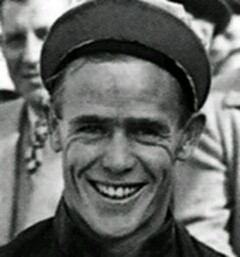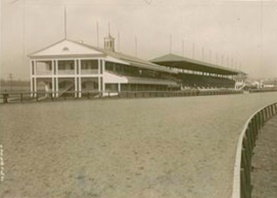Related Research Articles

Albert Snider was a jockey in Thoroughbred racing who had success in his native Canada as well as the United States.
The Philip H. Iselin Stakes is an American Thoroughbred horse race held annually at Monmouth Park Racetrack in Oceanport, New Jersey. Open to horses three years of age and older, the race was first run in 1884. In 1891, New Jersey state legislators began a move to ban parimutuel betting and the race had to be moved to the Jerome Park Racetrack and the Morris Park Racetrack in The Bronx, New York. With a legislated permanent ban, after the 1893 running the Monmouth Park Racetrack was shut down and the property sold. In 1946 Thoroughbred racing returned to a new Monmouth Park facility, spurred on by the burgeoning American economy after the end of World War II.
The Queens County Handicap is an American Ungraded Thoroughbred horse race run annually during the second week of December at Aqueduct Racetrack in Queens, New York. Open to horses age three years and older, it is contested on dirt at a distance of one and three-sixteenths miles.
The Westchester Stakes is a Grade III American Thoroughbred horse race for three-years-old and older run over a distance of 1+1⁄16 miles annually in early May at Belmont Park, in Elmont, New York. The event currently offers a purse of $100,000 added.

The Havre de Grace Racetrack was an American horse racing track on Post Road in Havre de Grace, Harford County, Maryland. Nicknamed "The Graw," it operated from August 24, 1912, to 1950. For a time, it was owned by the Harford Agricultural and Breeders Association and also by the notorious gambler Arnold Rothstein.
The Havre de Grace Handicap was an American Thoroughbred horse race first run on the August 26, 1912 opening day of the new Havre de Grace Racetrack in Havre de Grace, Maryland. Although most of its runnings would take place in early fall, its final edition was run there on April 30, 1949. Due to Federal government wartime regulations, the 1943 edition was held at Laurel Park and in 1945 at Pimlico Race Course. A race for horses age three old or older, it was run on dirt over a distance of 1 1/8 miles with the exception of 1918 when it was set at 1 mile and 70 yards. From inception through 1939, the race was known as the Havre de Grace Cup Handicap.
Cudgel (1914–1941) was an American two-time Champion Thoroughbred racehorse.

Omar Khayyam (1914–1938) was a British-born Thoroughbred racehorse who was sold as a yearling to an American racing partnership and who became the first foreign-bred horse to win the Kentucky Derby. He was named for the famous Persian mathematician, poet, and astronomer, Omar Khayyam.
Menow (1935–1964) was an American Thoroughbred racehorse. He won several important races in 1937, when he was voted American Champion Two-Year-Old Male Horse.

Milkmaid was an American two-time Champion Thoroughbred racehorse. She was bred by J. Hal Woodford at his farm in Bourbon County, Kentucky. Woodford had bred and raced the 1907 Kentucky Derby winner, Pink Star. Out of the mare, Nell Olin, her sire was the British import, Peep o' Day, a son of the great Ayrshire who won the 1888 2,000 Guineas Stakes and Epsom Derby then just missed winning the British Triple Crown when he ran second in the St. Leger Stakes.
The Maryland Racing Media Stakes is an American Thoroughbred horse race run in February of each year at Laurel Park Racecourse in Baltimore, Maryland.

Chance Play was an American Champion Thoroughbred racehorse and Champion sire. In a career which lasted from 1925 to 1928 he ran in thirty-nine races and won sixteen of them. Although he was successful in his early career over sprint distances, he did not reach his peak until the age of four in 1927, when he was arguably the best horse in the United States, winning several major races including the two-mile Jockey Club Gold Cup.
The Trenton Handicap was an American Thoroughbred horse race run annually at Garden State Park Racetrack in Cherry Hill, New Jersey. Open to horses age three and older, the race was contested on dirt at various distances during its tenure:
Bostonian was an American Thoroughbred racehorse. The son of Broomstick out of a Peter Pan mare Yankee Maid, Bostonian is best remembered for posting a 1-1/2 length win over his stablemate and Kentucky Derby Champion Whiskery in the mile and three sixteenth $65,000 Preakness Stakes at Pimlico Race Course on May 9, 1927

Billy Kelly was an American Thoroughbred racehorse who was the champion two-year-old in 1918 when he won 14 of 17 starts. Favored for the 1919 Kentucky Derby, he lost to his stablemate, the then lightly regarded Sir Barton, but Billy Kelly would beat Sir Barton in 8 of 12 head to head races. Billy Kelly would go on to win 39 races from 69 starts. He was elected to the National Museum of Racing and Hall of Fame in 2015.
The Philadelphia Handicap was an American Thoroughbred horse race held thirty-eight times between 1913 and 1950 at Havre de Grace Racetrack in Havre de Grace, Maryland. Run on dirt, the race was open to horses of either sex age three and older.
The Chesapeake Stakes was an important American Thoroughbred horse race for three-year-old horses of either sex contested on dirt over a distance of a mile and one-sixteenth at Havre de Grace Racetrack in Havre de Grace, Maryland. Run from 1920 until the track closed after the 1950 edition, the race usually run in late April race was a last major prep before the Kentucky Derby. For owners who had not nominated their horse for the Derby it was a chance to test their horse's ability against some of the best three-year-olds in the country, a number of which they would undoubtedly encounter in the ensuing Preakness Stakes.
The Eastern Shore Stakes was an American Thoroughbred horse race run between 1913 and 1949 at Havre de Grace Racetrack, in Havre de Grace, Maryland. A race for two-year-old horses of either sex, it was inaugurated and run for most of its existence as the Eastern Shore Handicap.
The Porter was an American Thoroughbred racehorse. He won 26 times from 54 starts in a career that lasted five years, and was second in the 1918 Preakness Stakes. He became an important sire, leading the North American sire list in 1937.
The Delaware Handicap was an American Thoroughbred horse race held between 1901 and 1937 at Saratoga Race Course in Saratoga Springs, New York. An event for horses of either sex age three and older, it was contested on dirt over a distance of one mile. While fillies accounted for just under a third of the winners, their victories were marked by a number of dominating performances.